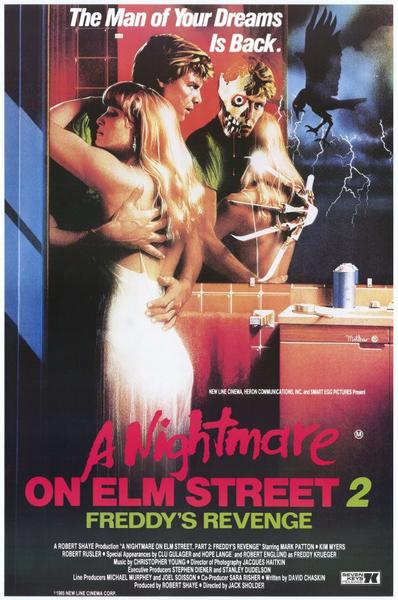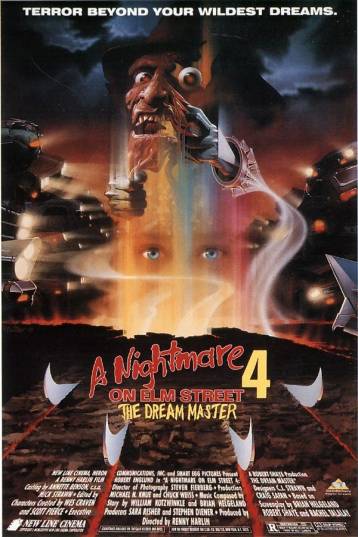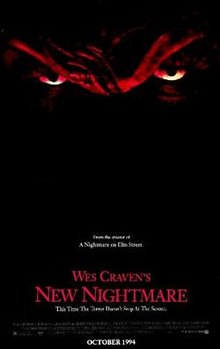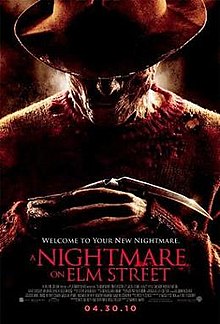
Three bloggers. Three horror icons. Three points of view.
Kelly Hager, Erik Kristopher Myers, and myself will be taking on Freddy Krueger, Jason Voorhees AND Michael Myers this October. What we liked, what we don’t like, or what was just plain stupid. Before we get to the action, let’s talk about ourselves for a second!

Kelly Hager
I’ve been a horror fan for 29 years; I prefer Freddy to Jason, Carpenter to Craven (but love both) and Romero zombies to faster ones. Besides all things horror, I love books, most movie genres and everything 80s. You can follow me on Twitter (@khager) or on my blog (www.kellyvision.wordpress.com)
Nick Frisone
I started Baltimore Media Blog back in 2009 to highlight the media and arts scene. I never imagined that it would grow to what it is today. This website has won multiple Baltimore Sun and Baltimore Magazine awards. Besides BMB, I sit on the board of the Highlandtown Community Association, various art and public safety task forces, and currently VERY active in the local Democratic Party.
You can follow me on Twitter and Instagram for daily musings, fun quips, and awkward photos.
Erik Kristopher Myers

This is easily one of my favorite horror franchises, probably because the first horror movie I ever watched was one of the sequels (more on that when we reach it). I’ve seen the entire series multiple times but this is one of the ones I know best. (A conservative estimate for this one is 20 times; I literally know it by heart.) The reason why I love this series so much (over Friday the 13th especially) is the fact that the characters are more than just carnage. I can never remember which characters are in which Friday the 13th movie (except for Alice in the first one and Tommy Jarvis in #4) but I definitely know which character is in which Elm Street.
It’s still scary, and that’s because Freddy (or “Fred,” as he’s known in here) has two goals: kill you and scare you before he does. The third movie is where he starts to become funny and the later installments slide even more into camp. I still love them, though (again, this series is a major part of my childhood…which probably explains a lot).
This also has one of my favorite tropes in it: the English class. Even better, the teacher in this is played by Lin Shaye. It’s fun to see someone who will eventually become a final girl herself in this role.
The reason the original works so well is that the teenagers really seem to be friends. I absolutely buy them as people who grew up together (especially Tina and Nancy). It’s nearly impossible not to love them.
Also it’s got Johnny Depp. So there’s that.
FAVORITE KILL: Tina.
FAVORITE FINAL GIRL LINE: “I’m into survival.”
Nick:
Out of the three series we’re covering, I feel this is the most frightening. Solely because everyone has the fear of going to sleep and never waking up.
The first entry is simply a horror classic. Instead of just dying in your sleep, you’re slaughtered somehow by the mad man Freddy Krueger. Wes Craven was masterful at bringing Freddy to life. This film could’ve fell into the 80’s “C horror movie trap” but it didn’t. The directing, the mood of the film, the villain, and especially the cast were right on point.
Heather Langenkamp as ‘Nancy’ is in my top three horror movie “final girls.” She gives an incredibly take charge performance. Usually you get one iconic death scene per film, but in this one we get TWO. Amanda Wyss and Johnny Depp get dispatched in a swirling, crawling goodness of blood.
Appointment viewing for up and coming horror fans!
Erik:
As children, we were all afraid of the Boogeyman: a formless threat who lived under our collective beds, lying in wait until the house was quiet so that he might creep out and kill us in our sleep. If there is one indisputable strength in Wes Craven’s A Nightmare on Elm Street, it’s the writer/director’s ability to synthesize the invisible iconography of childhood fear and give the Boogeyman both a definitive and universally recognizable identity. With his loose slouch, burnt face, crumpled Pervert Fedora, and optically-challenging red and green sweater, Freddy Krueger is Stranger Danger personified and the loping threat of innocence betrayed. Hell, he also lived under your bed, in a manner of speaking; the owner of a silhouette every kid dreads to see standing in the doorway long after Mommy and Daddy have fallen asleep. Even his calling card – the hair-raising sound of terrifyingly-long fingernails on a chalkboard – awakens a primal fear embedded deep in the subconscious of children and adults alike.
What amplifies this terror is Craven’s reversal of childhood expectation; Mommy and Daddy can’t ward off the Boogeyman because Mommy and Daddy created the Boogeyman. A Nightmare on Elm Street is a story that can only exist in the faraway days before the advent of the internet, as its heartbeat pumps blood through a narrative system built upon the secrets and lies our parents and community leaders hide in the closet while putting on a show of normality through elaborate Thanksgiving dinners and weekly trips to Sunday School. The horror behind picket fences in Anytown, USA, is the bad dream of both Liberal and Conservative America, as children inherit the mistakes of their well-meaning but ultimately doomed predecessors. While it isn’t difficult to sympathize with the Springwood parents who burnt Krueger alive for murdering their offspring, the perversion of the American dream into a literal and figurative nightmare of broken homes and familial dysfunction brilliantly underlined the sweeping social changes that were coming to a head in 1984 — changes that would inevitably inform the generations to follow. Truly, we are all Freddy Krueger’s children now.

Kelly:
I’m a lesbian so when I say that this movie is the gayest thing I’ve ever seen, I know what I’m talking about.
This is one of the three Elm Street movies that’s most mocked (the other two are Freddy’s Dead and the remake) and it’s deserved.
It’s arguably darker than the original but it also goes against many of the rules set there. In this one, Jesse, his parents and little sister move into Nancy’s house. It’s five years after the original, and weird things immediately start to happen. The house is always insanely hot, the family’s pet bird attacks them and then it basically explodes (spontaneous combustion, maybe?) and a toaster that’s not even plugged in catches fire. This aren’t even the weirdest events.
So what makes it gay, you ask? Well. The movie can be taken as a metaphor for being closeted, but I’m not sure it’s even really subtext. Jesse apparently loves his girlfriend Lisa but he seems a lot more into his friend Grady. Jesse is more upset at Grady’s death than he is at anything else in the movie, including the fact that he’s possessed by a serial killer. Which…sure.
This is probably my least favorite of the series. It’s better done than Freddy’s Dead, but it’s really disjointed and if my movies can’t be scary, they should at least be fun. This one isn’t either.
Favorite kill: the Coach. (I feel like I should say Grady, but it just makes me sad for Jesse.)
Nick:
I’m not gonna lie. I’m not thrilled with this entry. It just..bores me. The lead character isn’t interesting at all. However, the homo-eroticism just can’t be ignored. (Hot!) You didn’t see that in horror films at that time. There are some pretty cool scenes in this one though. The scene where Freddy crashes the pool party is tubular, as well as the ending sequence in the bus.
Can we skip to Part 3 already?
Erik:
Thanks to the internet, the subtext found in Freddy’s Revenge has unfairly become that which, for better or worse, will forever define the film. Term paper discussions on the narrative’s suspected metaphor for latent and emerging homosexuality in the homophobic upper-middle class suburbia of the mid-1980s are no longer the late-night speculation of horror fans; latter-day bloggers and would-be critics lacking historical reference betray their vantage point by simply referring to it as “the gay one.” Yet Freddy’s Revenge is indeed oozing with homoeroticism, whether through the pseudo-sexual courtship of its male-on-male-on-male love triangle (because let’s face it: we all know Lisa is both a fourth and a fifth wheel in the Jesse/Grady/Krueger threesome), or our protagonist’s fear that his physical compulsions are manifesting in the form of a hideous, destructive, and unlovable Other who hides inside his body, both alienating and annihilating his friends and family. In the Reagan years of extreme political conservatism and the burgeoning AIDS panic, Freddy’s Revenge functions as much as a social mirror as its predecessor, offering an alternative reflection of a society struggling to maintain its footing on shaky ground.
While there is much in Freddy’s Revenge that remains incongruous with Craven’s premise, it cannot be overstated that it is, in fact, the only sequel in the eventual franchise (until New Nightmare) to take risks and carve its own path, while simultaneously offering far more to ponder and dissect than any of the films to follow. It is also the last time that Krueger would display true menace in a hallucinogenic world of waking dreams and blurred reality, much to the detriment of the series in light of its eventual descent into camp. While it’s both unfair and troubling to see a male-dominated fan base dismiss Freddy’s Revenge as A Rainbow on Elm Street, it’s the peril of that pesky social mirror I was talking about; response to the film says more about those watching it than the concepts contained within. But make no mistake: Freddy’s Revenge is the second-best film in the series, as it challenges genre conventions and social norms, and confronts its audience with material that seems designed to provoke a response. In that sense, Freddy’s Revenge is a home run. “You’ve got the body, I’ve got the brain,” indeed.

Kelly:
As I think I mentioned before, this is my favorite horror franchise. This sequel is a big part of the reason why. Dream Warriors grew the mythology by giving the victims special dream powers they could use to fight Freddy (to varying degrees of success, of course) and best of all, Nancy is back.
The scene where Nancy first appears is one of my favorites. Kristen is in an asylum and is clutching a scalpel and crying while chanting the Freddy jump rope song. She can’t finish but then Nancy does. (Cue me, doing a Judd Nelson fist pump.)
This also features one of horror’s biggest tropes: teenagers explaining what’s going on and adults not believing it. We get a bonus cliché: the backstory delivered by someone who turns out to be dead. We learn about how Freddy was conceived from a nun who turns out to be his mother. It’s a little ridiculous but this is the last movie to play it even a little straight, though this is the first movie where Freddy starts to enjoy his puns and wordplay. (He basically becomes the Roger Moore/Pierce Brosnan James Bond, where every death is a joke.)
This is also really fun because it features future Oscar winner Patricia Arquette and nominee Laurence Fishburne. (Who is actually credited as “Larry Fishburne” in this, which makes me laugh every time I see it.)
Favorite death: Phillip. It’s so creepy and so sad.
Nick:
This is the entry that introduced me to Freddy Krueger. I remember it being on syndicated ‘Nightmare’ theater back in the early 1990’s. I vividly remember the scene where the kids came out of the mirrors towards the end of the film.
This is quite frankly the best sequel of the franchise. Some might say they’re corny, but some of the dream sequences are just bad ass! One of the mental patients, who is also an aspiring actress, is picked up by Freddy (WHO IS INSIDE THE TELEVISION) and bashes her head into it. The character of Taryn is turned into a bad ass fighter, who unfortunately succumbs to Freddy by use of ten claw like syringes full of drugs.
One of the things I love most about the film is the characters and cast are so memorable. I can’t even remember who was in Part 2 or 5 quite honestly. The mood of the film reminded me of the first one, while the second one left me cold.
Welcome to prime time, BITCH.
Erik:
Popular theory holds that Dream Warriors is the best sequel in the Nightmare on Elm Street franchise, if not the best film overall. While this is a tempting line of thought, it’s somewhat tempered by hindsight. Indeed, it’s here that Freddy Krueger’s gangrenous Henny Youngman schtick first rears its ugly head, like the early stages of a terminal illness that will ultimately consume the character with its festering malignancy. As with other literary and cinematic monsters well past their expiration date, Krueger — barely three films into his decade-long heyday — is defanged and repackaged as a Saturday morning cartoon, rendering him as threatening as a vampiric Muppet teaching toddlers how to count, or a pink Frankenberry encouraging masticating children from the back of a cereal box. Here for the first time, Krueger is the star of the film, and the rounding off of his sharper edges becomes immediately apparent. Dream Warriors is hardly Stage Four cancer – that would come later – but the transformation of Freddy from shadowy Kiddie Toucher into punning MTV Guest VJ had a profound effect on the overnight mainstream popularity of the series, as well as its equally-sudden descent into cataclysmic pop culture irrelevancy. Welcome to prime time, bitch.
Our antihero’s center stage antics aside, the film’s appeal with those who hold it in such high regard stems primarily from the shift from Horror to Dark Fantasy; whether one considers this a bold departure, next logical step, or jumping of the shark is largely dependent on personal preference. It goes without saying that Dream Warriors is wonderfully inventive in its creative REM dreamscapes (low budget notwithstanding), and the concept of Krueger’s victims harnessing their inner strength to use against him is equal parts hamfisted and inspired. Yet for every bold new idea, we step further away from Craven’s original premise. The unfortunate infusion of Catholic booa-booga and faux-gothic backstory creates an over-familiarization and relatability to what should be a shadowy, archetypal monster. It robs Krueger’s terrifying power over us once he’s seen prancing about in full light with his name, address, social security number, interests, and hobbies laid out like a Match.com profile. Fear is birthed by both the unknown and unknowable; this guy murders Zsa Zsa Gabor on The Dick Cavett Show for a cheap laugh from kids who don’t have the first clue who these people even are. While this doesn’t make Dream Warriors a bad film by any stretch, it’s a cautionary reminder of what happens when a product is watered down for mass appeal – after a while, it doesn’t taste like anything anymore, despite the addition of new packaging, colors, or flavors. The road to Hell is paved with commercial intentions, after all.

Kelly:
I wish that I had been in the room when they were discussing how to bring Freddy back. Was the idea of him being reanimated by flaming dog pee (yes, really) a lost bet? Was it a placeholder? Like, were they sure they’d come up with something better but they didn’t know what and then they just ran out of time? I am so curious about this.
We also learn that Kristen (now played by Tuesday Knight) is the last girl that Freddy can kill…unless she brings him someone else. (Every other teen whose parents were responsible for killing him is dead. And remember how Kristen can bring people into her dreams? She chooses Alice, which then gives him access to all Kristen’s other friends.)
Anyway. This is the Elm Street where we meet the series’ other iconic final girl, Alice. (And can I just say that I love Alice?) She starts off as this super shy girl but ends up a badass. It’s basically like seeing Sarah Connor go from Terminator to Terminator 2.
Favorite death: Debbie. It’s so gross (Debbie is terrified of bugs and roaches, so Freddy turns her into one. And then traps her in one of those bug sticky traps, and then squashes it).
Nick: I like most of this film. It sets up a cool two film arc for Alice (played by Lisa Wilcox). She starts out being the shy one, but ends up a bad ass. The film was shooting during a writers strike, so you can tell some of this was half assed. Even some of the dialogue is weak. I also wonder if Patricia Arquette had come on board, would Kristen have survived, or at least been killed off toward the end a la Nancy from Part 3?
Also, Debbie’s death scene is just fucking gross. They couldn’t come up with ANYTHING else?!
(Shout out to the awesome Toy Newkirk who plays Sheila in this. She’s a sweet heart!)
Erik:
Roughly half an hour into A Nightmare on Elm Street 4, the concept of an altruistic dream guardian is introduced by way of the clumsy bastardization of an 18th century prayer; the execution is about as successful as cooking a Thanksgiving turkey in the microwave. “And now I lay me down to sleep / The Master of Dreams my soul will keep / In the reflection of my mind’s eye / Evil will see itself, and it shall die.” This complete and total misunderstanding of rhythm, rhyme and meter exemplifies the greater issues inherent within The Dream Master, a film that shambles along drunkenly from set piece to set piece without any coherent sense of pacing, purpose or direction. If the storyline feels as though it’s based less upon a finished screenplay than a series of elaborate FX sequences written on index cards, it’s because it was: the writer’s strike of 1988, coupled with New Line Cinema’s prioritization of release date over script, resulted in a narrative that was largely improvised during production. As such, the themes of individual and group empowerment that felt so novel in Dream Warriors are reduced to video game-style level-ups in this fourth installment, as we watch our heroine simply inherit the “dream powers” of her (largely improbable) group of dying friends. The previous concept of social and familial misfits harnessing their unrealized (but singular) fantasies in order to take control of their lives – both waking and asleep – is tossed into the boiler in favor of turning our Final Girl into a ninja with an electronic bug zapper. Never underestimate the importance of a screenwriter, friends.
Commonly referred to as “The MTV Nightmare,” The Dream Master is indeed as slick and choreographed as an expensive music video, and about as empty. Director Renny Harlin’s visual style and commercial sensibilities made this the most successful Nightmare from a financial standpoint; it also sealed Freddy Krueger’s fate as a perennial game show host, doomed to award seemingly ironic (and heavily telegraphed) deaths to paper-thin Breakfast Club stereotypes. There’s no one to care about, but that’s sort of the point here, because Freddy’s no longer the one we’re supposed to be rooting against – at least not until the third act, when everything turns into a bizarre martial arts flick set inside the ruins of a gothic church. While the final moments of said climax are remarkably effective, and features Krueger’s most inspired demise, we have to wonder which fatal reflection of himself he saw in the Dream Master’s mirror: the soulless child killer, or the soulless lunchbox caricature.

Kelly:
This was the first horror movie I ever saw (I was nine) and because of that, I have a huge fondness for this movie. Yes, it’s cheesy. Yes, it’s edited to the point where every death is a little lame. And yet, I love it so much.
In this latest installment, Freddy kills Alice’s boyfriend Dan…just in time for her to learn she’s pregnant. And, as you may have guessed from the subtitle, Freddy’s figured out how to use this pregnancy for his own gain.
One of the things I love the most about this franchise is the fact that it does tend to keep bringing its cast back. Friday the 13th had multiple people playing Tommy Jarvis, but Lisa Wilcox is back as Alice, Danny Hassel is back as her boyfriend, Dan, and even the guy who plays her father is back. (Nick Mele, in case it comes up on Jeopardy.) Previous movies are referenced, and not just the Freddy Krueger origin story.
Favorite death: I guess Dan? (Actually, if we’re being really honest, probably Mark. I KNOW IT’S LAME. But I have a huge sense of nostalgia for this movie.)
Nick:
::sigh:: This is where the franchise gets dicey for me. I LOVED Mark’s death scene. It’s kinda cool. But Greta’s? It gives me acid reflux every time I see it. The one great constant is Alice. But other than that? This entry just falls flat for me.
Now if you’ll excuse me, I need a Tums.
Erik:
There’s a classic moment in Rob Reiner’s This is Spinal Tap in which the director, playing documentary filmmaker Marty DiBergi, reads the aging heavy metal band a sample of their past critiques. When coming to their stupidly-named Shark Sandwich, DiBergi cites a review from an unnamed publication, who summarizes their opinion in two succinct words: “Shit sandwich.” Using this analogy, A Nightmare on Elm Street 5 can equally be defined as a massive, crap-stuffed hoagie, but with the generous addition of heavily congealed cheese. Which topping is worse: the belabored (and then ultimately edited-to-the-brink-of-pointlessness) Pro-Life subplot, or the intrusion of a child actor who is intended to be adorable but looks less human than our child-killing antagonist? Who cares? Pass the ketchup packets; they’re literally the only thing resembling gore you’ll get out of this diarrhetic feast (thanks to a particularly vindictive series of cuts dictated by the MPAA).
The most remarkable thing about The Dream Child is its unintentional similarity to the dreamscape within which it’s set: the narrative movements are so vague, muddled and listless that the film remains only half-remembered the moment it’s over. Repeat viewings bear this out, underlining the fact that there isn’t so much a “story” as a series of connected scenes (SEE: Batman and Robin). Thus, trying to explain the film becomes less like telling a story than constructing a list of THINGS THAT HAPPENED, and then trying to figure out the order in which they occurred. Meanwhile, Freddy Krueger’s burn makeup has been redesigned to the point of bland politeness, and the presumed on-screen budget one would predict following the box office-shattering Dream Master is literally nowhere to be seen. Like a bad dream, it’s a hazy, ugly, confusing, and elusive memory once it mercifully ends; while it’s playing, though, one feels the ironic desire (given the film’s Pro-Life sentiments) to kill the franchise and put it out of its misery.

Kelly:
I have the hardest time with this movie and it’s primarily because it’s so uneven. When I think about it (which I rarely do), I remember Spence’s death. I never remember how dark the rest of it is until I rewatch it, and I almost never watch it. (I’ve probably still seen it about a dozen times over the 20 years or so since it’s been out, but this and Freddy’s Revenge are the ones I know least well. And the remake, if you count it…which I really don’t.)
Because yeah, this movie is DARK. Most of the teenagers have major trauma (Carlos was abused, which left him deaf; Tracy was molested by her father) and we learn that Freddy had a wife and daughter. He murdered the wife, which led to the daughter being taken away. Also, since all of Springwood’s children have been murdered, the adults are all varying levels of insane.
If the movie had stayed dark, I think it would’ve been one of the best installments of the franchise. Instead, they put Spencer’s death in (he’s killed in a video game and it’s a really fun sequence but it’s also incredibly jarring).
BUT next up are two of my favorite Freddy movies: Wes Craven’s New Nightmare and Freddy vs. Jason. (Also the remake, but I’m not thinking about that until I have to.)
Favorite death: Carlos. It’s seriously awful.
Nick:
This is my least favorite of the franchise. And NOT just because Roseanne makes a cameo. The film takes on some heavy subjects but a lot of it is just silly. However, the part when Freddy is riding the broom stick like The Wicked Witch Of The West? Gives me the giggles every time.
Erik:

This may be my actual favorite of the Elm Street sequels. It almost serves as a rough draft for Scream; this is Wes Craven’s OTHER 90s-era meta horror movie. It’s darker and much less funny but you can definitely see the early seeds of Scream in it. There’s also so many references to the first Nightmare in this.
I also love how many people in this movie are playing themselves (or a version of themselves). We see Wes Craven, Bob Shaye, Sara Risher and other New Line execs, as well as Heather Langenkamp, John Saxon and Robert Englund. It almost makes this feel like the movie is actually happening. (Except Freddy’s makeup is really not great in this. It looks almost rubbery, and that’s a weird choice.)
It’s also really nice to see Freddy be scary again. (There are no jokes here.) This is my favorite horror franchise and this is a huge reason why. It’s incredibly smart and doesn’t feel like we’ve seen it a billion times before.
Favorite kill: Julie. It’s a major callback to Tina’s death in the first one and it’s so relentless.
Writer/Director Wes Craven stated numerous times before his untimely passing that his Elm Street epilogue, New Nightmare, was either the best or worst idea in the world. Acting as an attempt to deconstruct the very series he had created, the film functions as a meta-textual narrative in which the actors and creative forces responsible for the original film are now haunted by Freddy Krueger, who is attempting to escape the silver screen and cross over into reality. Within this alternate-reality framework, actress Heather Langenkamp — the Final Girl who set the standards for others to follow — must confront her responsibility in helping to initiate a pop culture Slasher who became the idol of children worldwide; this plays out in the obsessive behavior of her child, giving her a front row view of the effects of horror movies on young audiences.

This is one of the movies I’m really conflicted about. It’s got a lot going for it (fun cast; good kills; lots of throwbacks to the original) but it’s also not particularly great. Jackie Earle Haley does as good a job as any not-Robert Englund person can do, but he’s basically garden variety unsettling; Robert Englund is iconic.
My personal biggest problem though is one scene toward the very end. As backstory, this film makes it explicitly clear that Freddy molested children. (It was subtext in the original series; this one makes it clear. It seems at first that the kids made it up and that’s why Freddy’s killing them now; we learn toward the end that no, he really did it.) And there’s a scene where Nancy is a teenager but in a dress that’s more suited to a little girl. It’s just really creepy and not in the fun way. Every time I watch, I feel really gross about it. I’m hoping that’s the point.
I always enjoy it more than I think I will and then I reach that scene and it’s like, SCREECHING HALT.
(Connie Britton is great, though.)
It also killed the franchise, so there’s that, too.
Favorite kill: Kris. It’s a great homage to Tina’s death.

2 thoughts on “31 Days of Halloween: “A Nightmare On Elm Street””
Comments are closed.